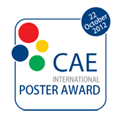CETMA and Avio are working together in a research project whose aim is the design of an innovative ceramic stator vane of a gas turbine for aircraft application. The first part of the work regards the structural design of the assembly containing the ceramic vane for the burner rig test simulating the gas turbine operating conditions (start-up, hold and shut down).
The main interest for ceramic components in the low pressure stage of gas turbine is the possibility to reduce the air cooling thanks to the higher operating temperature of ceramic materials.
A coupled thermomechanical simulation was carried out in order to identify the main thermal stresses that each part of the stator undergoes (metallic platforms, ceramic vane and so on).
The hot gas temperature profiles around the platforms, the vane and the other components came from a previous CFD analysis performed by AVIO. In this phase of the work a great effort was necessary in order to implement in the ANSYS numerical code (ANSYS Classic) the detailed boundary conditions necessary in order to identify the thermal stress hot spots.
First of all a 2D transient thermal analysis was carried out in order to define the best ceramic vane geometry. Then a complex 3D configuration was considered.
A cooling system was necessary in order to avoid high temperatures on metallic components. In order to simulate the effect of the cooling system the thermostructural analysis was combined with a detailed fluid network.
Simulations were carried out in stationary and transient conditions using different ceramic materials (Si3N4, SiC, Al2O3). The thermomechanical properties of ceramic materials were supplied by other companies, involved in the project, whose role regards the manufacturing of some ceramic vane prototypes. A sensitivity analysis was then carried out.
Finally, in order to identify the reliability of the ceramic vane, the thermomechanical analyses performed with ANSYS were combined with CARES/Life (Ceramic Analysis and Reliability Evaluation of Structures), a postprocessor developed by NASA. The code is based on the Weibull probabilistic distribution and it’s suitable for the analysis of ceramic materials. The final output was the probability of failure of the ceramic vane subjected to the transient thermomechanical loading. At the end combining ANSYS with CARES it’s possible to set-up a life prediction methodology for brittle materials. |




